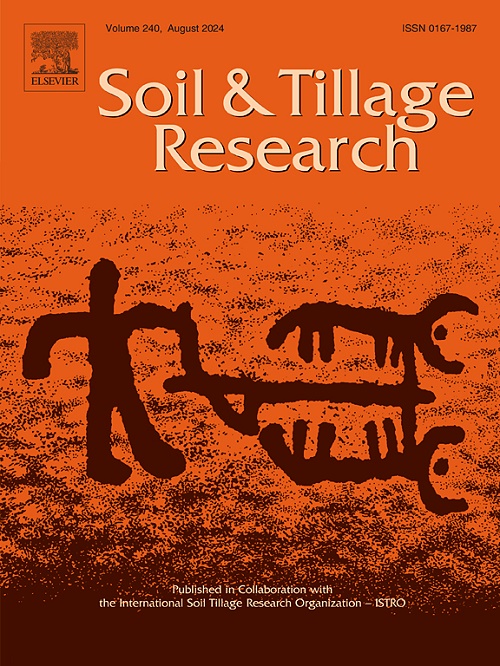Long-term response of bahiagrass pastures to elevated atmospheric CO2 and fertility management: Forage quality
IF 6.1
1区 农林科学
Q1 SOIL SCIENCE
引用次数: 0
Abstract
Southeastern US pasture systems remain understudied agro-ecosystems as affected by elevated atmospheric CO2 concentration. A long-term study of bahiagrass (Paspalum notatum Flüggé) assessed responses to elevated CO2 on a Blanton loamy sand (loamy siliceous, thermic, Grossarenic Paleudults). Pastures were exposed to ambient or elevated (ambient plus 200 μmol mol−1) CO2 using open-top field chambers. Based on extension soil test recommendations, half of all plots received N [(NH4)2SO4] at 90 kg ha−1 three times yearly plus K, P, and lime (managed) while remaining plots received no fertilization (unmanaged). For 10 years, bahiagrass from all treatments were assessed for impacts on forage quality using forage from yearly August harvests. These routine analyses included, crude protein, acid detergent fiber, neutral detergent fiber, lignin, total digestible nutrient, relative forage quality, NO3-N, digestible protein, crude fiber, net energy calculations, metabolizable energy and elemental concentrations (C, N, P, K, Ca, Mg, B, Cu, Fe, Mn, Na, and Zn). Fertilization clearly increased productivity and forage quality (e.g., forage N, crude protein, digestible protein) indicating that southeastern US bahiagrass pastures would benefit from proper soil fertility management. Despite reductions in some forage elemental concentrations under managed conditions, nutrients expressed on a land area basis (content) were increased. Effects of elevated atmospheric CO2 were much smaller and less consistent which may be reflective of a long-term C4 plant response. Additional research is required to determine if our findings are applicable to other southeastern pasture systems.
百喜草草场对大气CO2升高和肥力管理的长期响应:牧草质量
美国东南部牧场系统受大气二氧化碳浓度升高影响的农业生态系统研究仍未充分。一项对百海草(Paspalum notatum fl gg)的长期研究评估了对布兰顿壤土砂(壤土硅质,热的,大沙系古生砂)升高的CO2的响应。采用开放式野外试验室,将牧场暴露于环境或升高(环境+ 200 μmol mol−1)的CO2环境中。根据推广土壤试验建议,半数地块每年三次施用90 kg ha−1 N [(NH4)2SO4] + K、P和石灰(有管理),其余地块不施肥(无管理)。采用每年8月收获的牧草,评价了不同处理对百喜草牧草品质的影响。这些常规分析包括粗蛋白质、酸性洗涤纤维、中性洗涤纤维、木质素、总可消化营养物质、相对饲料品质、NO3-N、可消化蛋白质、粗纤维、净能计算、代谢能和元素浓度(C、N、P、K、Ca、Mg、B、Cu、Fe、Mn、Na和Zn)。施肥明显提高了生产力和饲料质量(如饲料氮、粗蛋白质、可消化蛋白质),表明适当的土壤肥力管理将使美国东南部百喜草牧场受益。尽管在管理条件下某些饲料元素浓度有所降低,但以土地面积为基础的营养成分(含量)有所增加。大气CO2升高的影响要小得多,也不太一致,这可能反映了C4植物的长期响应。需要进一步的研究来确定我们的发现是否适用于其他东南部牧场系统。
本文章由计算机程序翻译,如有差异,请以英文原文为准。
求助全文
约1分钟内获得全文
求助全文
来源期刊

Soil & Tillage Research
农林科学-土壤科学
CiteScore
13.00
自引率
6.20%
发文量
266
审稿时长
5 months
期刊介绍:
Soil & Tillage Research examines the physical, chemical and biological changes in the soil caused by tillage and field traffic. Manuscripts will be considered on aspects of soil science, physics, technology, mechanization and applied engineering for a sustainable balance among productivity, environmental quality and profitability. The following are examples of suitable topics within the scope of the journal of Soil and Tillage Research:
The agricultural and biosystems engineering associated with tillage (including no-tillage, reduced-tillage and direct drilling), irrigation and drainage, crops and crop rotations, fertilization, rehabilitation of mine spoils and processes used to modify soils. Soil change effects on establishment and yield of crops, growth of plants and roots, structure and erosion of soil, cycling of carbon and nutrients, greenhouse gas emissions, leaching, runoff and other processes that affect environmental quality. Characterization or modeling of tillage and field traffic responses, soil, climate, or topographic effects, soil deformation processes, tillage tools, traction devices, energy requirements, economics, surface and subsurface water quality effects, tillage effects on weed, pest and disease control, and their interactions.
 求助内容:
求助内容: 应助结果提醒方式:
应助结果提醒方式:


